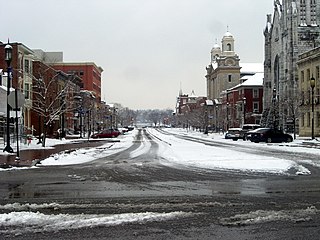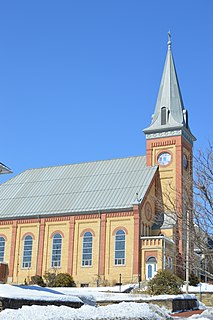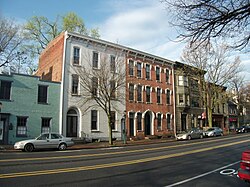
South Bethlehem Downtown Historic District is a national historic district in Bethlehem, Northampton County, Pennsylvania, in the United States.

Tyrone Borough Historic District is a national historic district located at Tyrone, Blair County, Pennsylvania. The district includes 349 contributing buildings and 2 contributing structures in the central business district and surrounding residential areas of Tyrone. The earliest buildings date to the 1850s, when the community was expanded as a junction town for the Pennsylvania Railroad. The buildings are primarily frame and brick, with notable examples of Late Victorian style architecture. Notable non-residential buildings include the Garman Building (1890), Hiller Building (1892), I.O.O.F Building, Jones Building (1906), White House Bed and Breakfast (1855), and St. Matthews Catholic Church (1880). Also located in the district are a railroad bed and viaduct and road bridge at East 10th Street and Blair Avenue. Located in the district and separately listed is the Tyrone Armory.

Williamsburg Historic District is a national historic district located at Williamsburg, Blair County, Pennsylvania. The district includes 362 contributing buildings and 6 contributing structures in the central business district and surrounding residential areas of Williamsburg. The earliest buildings date to the 1830s, when the community was expanded as a canal town along the Pennsylvania Main Line Canal. The buildings are primarily frame and brick, with notable examples of Federal and Late Victorian style architecture. Notable non-residential buildings include the Schwab Hotel, Hollidaysburg Trust Company (1873), Presbyterian Church (1841), Zion Lutheran Church (1907), Church of the Brethren (1911), Williamsburg High School (1918), and Community Elementary School (1941). Also located in the district are Presbyterian, Methodist, Lutheran, and Lutheran and German Reformed cemeteries; Big Spring; and the Pennsylvania Main Line Canal and Pennsylvania Railroad right-of-way.

Harrisburg Historic District is a national historic district located at Harrisburg, Dauphin County, Pennsylvania. The district includes 340 contributing buildings and 1 contributing site in a 19th-century residential area of Harrisburg. It contains the original core of the city. Located in the district is Harris Park, which unifies the district. Notable buildings include the Y.M.C.A. (1932), William Maclay Mansion (1792), Grace Methodist Church (1871), St. Stephen's Episcopal Cathedral (1826), St. Michael's Lutheran Church (1906), Cathedral of Saint Patrick (1907) and the Unit Row Houses. The John Harris Mansion is located in the district and listed separately.

Downtown Indiana Historic District is a national historic district located at Indiana in Indiana County, Pennsylvania. The district includes 86 contributing buildings and 1 contributing site in the central business district and surrounding residential areas of Indiana. The district includes notable examples of buildings in the Italianate, Second Empire, and Queen Anne styles. Notable buildings include the Federal-style William Houston House, Clawson Hotel, Thomas Sutton House, Calvary Presbyterian Church, Zion Lutheran Church, First United Presbyterian Church, and First Methodist Episcopal Church. The contributing site is Memorial Park, established as a burial ground in the early 19th century. Located in the district and listed separately are the Silas M. Clark House, James Mitchell House, Old Indiana County Courthouse, Indiana Borough 1912 Municipal Building, Indiana Armory, and Old Indiana County Jail and Sheriff's Office.

Cambria City Historic District is a national historic district located at Johnstown in Cambria County, Pennsylvania. The district includes 198 contributing buildings and 1 contributing structure in a predominantly working-class residential area of Johnstown. Though predominantly residential, it also includes a small business district and industrial buildings such as a former brewery, bottling plant, and slaughter house, along with a notable collection of churches, schools, and fire station. The district includes some buildings dated before the Johnstown Flood, but the majority date from 1890 to 1920. Notable buildings include the collection of two-story, balloon frame, detached and semi-detached dwellings, Fifth Avenue Hotel (1889), Pollack Building (1905), former Cambria Fire Hose and Ladder Company (1890), former Germana Brewery (1907), August and Louisa Mayer Building (1907), Tulip Bottling Company (1913-1949), St. Casimer's Polish Church (1907), Immaculate Conception Church (1908), St. Stephen's Slovak Church (1914), St. Columba Church (1914), St. Mary's Greek Catholic Church (1922), Venue Of Merging Arts, Hungarian Reformed Church (1902), and First Catholic Slovak Band Hall (1913-1949). The contributing structure is the Minersville Bridge (1914).

Moxham Historic District is a national historic district located at Johnstown in Cambria County, Pennsylvania. The district includes 330 contributing buildings in a predominantly residential area in southern Johnstown. There are 315 contributing dwellings, 17 former carriage house / horse barns, 21 commercial buildings, 10 churches, and one former school. The district includes five contributing buildings dated before the Johnstown Flood, but the majority date from 1890 to 1930. The dwellings include notable examples of popular architectural styles including Bungalow/craftsman, Colonial Revival, and American Foursquare. Notable non-residential buildings include St. Patrick's Catholic Church (1905), former Calvary Methodist Church (1894), Allegheny Wesleyan Methodist Church (1898), Grove Avenue Methodist Church (1902), Second Presbyterian Church (1914), and former Cypress Avenue School (1900).

Patton Historic District is a national historic district located at Patton in Cambria County, Pennsylvania. The district includes 42 contributing buildings in a predominantly residential area of Patton. The predominant architectural style is American Foursquare, with some notable examples of Colonial Revival and Romanesque Revival styles. Notable buildings include the St. Mary's Church (1899), St. Mary's Rectory (1899), St. Mary's School (1913), A. O. Summerville House, W. H. Sanford House, Charles Rhody House, Dr. Stiles House (1907), Prindible Houses, Trinity United Methodist Church (1901), St. Peter and Paul Orthodox Church (1904), Cambria Heights Middle School (1894), and Patton High School (1903).

Stoystown Historic District is a national historic district located at Stoystown in Somerset County, Pennsylvania. The district includes 81 contributing buildings, two contributing sites, and one contributing object. It encompasses central business district and surrounding residential areas in Stoystown. They primarily date from the late-19th and early-20th century. Notable non-residential buildings include the Grace Lutheran Church (1888), St. Paul's United Church of Christ (1897), John Griffin Building, Laurel Bank (1922), former Custer House, H.J. Specht Hardware, former IOOF Hall, and former public school (1929). The contributing sites are the Union Cemetery and Stoystown-Quemahoning Township Area Recreation Park. The contributing object is a Lincoln Highway marker (1928). Located in the district and separately listed is the Hite House, dated to 1853.

Boiling Springs Historic District is a national historic district located at Boiling Springs, Cumberland County, Pennsylvania. The district includes 127 contributing buildings, 1 contributing site, and 1 contributing structure associated with its role as an early iron manufacturing center and surrounding residential areas of Boiling Springs. Most of the contributing buildings date to the mid-19th century starting in 1845, with a few dated to the early period of development. The oldest buildings are a grist mill, ironmaster's mansion (1795), and the restored Boiling Springs Tavern (1832). Other notable non-residential buildings include the former stone stables (1829) and forge building (1850s). Residential areas include notable examples of the Bungalow/craftsman, Late Victorian, and Federal styles. The contributing structure is a stone three-arched bridge (1854).

The Mechanicsburg Commercial Historic District is a national historic district located at Mechanicsburg, Cumberland County, Pennsylvania. The district includes 91 contributing buildings in the central business district of Mechanicsburg. Most of the contributing buildings date to the 19th century and includes notable examples of the Late Victorian and Georgian styles. Notable buildings include two churches, two banks, and the police department.

Shippensburg Historic District is a national historic district located at Shippensburg, Cumberland County, Pennsylvania. The district includes 324 contributing buildings in the central business district and surrounding residential areas of Shippensburg. Most of the contributing buildings date to the mid- to late-19th century, with a few dated to the mid-18th century. Residential areas include notable examples of the Late Victorian and Vernacular Georgian styles. The oldest buildings are log and stone structures and include the Shippen House and Widow Piper's Tavern. Other notable buildings are the Rippey House, William Brookins House, Steward-Goodhart House, Methodist Church, Lutheran Church, and Presbyterian Church.

The Newville Historic District is a national historic district which is located in Newville, Cumberland County, Pennsylvania. The district is bordered roughly by Cove Alley, Big Spring Creek, the right-of-way for the Cumberland Valley Railroad, and Washington Street, and encompasses 414 contributing buildings, one contributing site, and two contributing objects in the central business district and surrounding residential areas of Newville.

Mercersburg Historic District is a national historic district centered on the center square of Mercersburg in Franklin County, Pennsylvania. The district includes 124 contributing buildings and 1 contributing site in the central business district and surrounding residential areas of Mercersburg. The residential buildings include a number of sheathed log, stone, and brick dwellings, with some dating to the 18th century. The district has a number of notable examples of the Federal, Greek Revival, and Colonial Revival styles.

Chambersburg Historic District is a national historic district centered on the Memorial Fountain and Square of Chambersburg in Franklin County, Pennsylvania. The district includes 159 contributing buildings in the central business district and immediately surrounding residential area of Chambersburg. The district has a number of notable examples of Georgian and Italianate style architecture. Notable buildings include the St. Paul United Methodist Church (1896), Professional Arts Building, Cumberland Valley National Bank, Cumberland Valley Railroad Station, First United Brethren Church (1899), firehouse, Presbyterian Church of the Falling Spring (1803), and the Suesserott House. Located in the district and separately listed are the Franklin County Jail, Franklin County Courthouse, John Brown House, Masonic Temple, Townhouse Row, and the Zion Reformed Church.

High Street Historic District is a national historic district located in Pottstown, Montgomery County, Pennsylvania. It encompasses 124 contributing buildings and 1 contributing structure in an upper- and middle-level residential section of Pottstown. The district includes late-19th and early-20th century mansions and stylish homes built between 1860 and 1941. They are in a variety of popular architectural styles including Queen Anne, American Foursquare, Victorian Gothic, Late Federal and Italianate. Notable non-residential buildings include a gas station, St. John's Reformed Church (1916), St. James Evangelical Lutheran Church, and Pottstown Memorial Hospital. It includes the separately listed Grubb Mansion.

Tamaqua Historic District is a national historic district located at Schuylkill Township and Tamaqua, Schuylkill County, Pennsylvania. The district includes 944 contributing buildings, 3 contributing sites, 8 contributing structures, and 3 contributing objects in the central business district and surrounding residential areas of Tamaqua. The residential buildings principally date to the early 20th century. They are mostly two-story, of brick and frame construction, and in a variety of popular architectural styles including Queen Anne, Late Victorian, Italianate, and Colonial Revival. Notable non-residential buildings include the Little Schuylkill Hotel (1827), White Swan, Washington House, Shepp Building, Elks Lodge, Peoples Trust Company Building, Tamaqua National Bank (1908), First National Bank of Tamaqua, U.S. Post Office (1932), Majestic Theater and Hotel, Hegarty Blacksmith Shop (1848), Conrad Biscoff Planing Mill and Furniture Factory (1865), Tamaqua Manufacturing Company (1910), Calvary Episcopal Church (1851), First Methodist Church (1852), St. Jerome's Roman Catholic Church (1856), American Hose Company (1881), East End Fire Co. (1923), and the former Tamaqua Armory. The contributing sites are St. Jerome's Cemetery, Odd Fellows Cemetery (1865), and the foundation of the Fitzpatrick Shirt Factory (1888). Contributing structures include three runs of iron steps and five bridges. Located in the district and separately listed are the Anthracite Bank Building, George Ormrod House, and Tamaqua Railroad Station.

Eagles Mere Historic District is a national historic district in the mountain lake resort of Eagles Mere in Shrewsbury Township, Sullivan County, Pennsylvania. The resort area was founded in the late nineteenth century and popular through the first half of the twentieth century. It surrounds Eagles Mere Lake.

Union City Historic District is a national historic district located at Union City, Erie County, Pennsylvania. It includes 96 contributing buildings and 1 contributing structure in the central business district and surrounding residential areas of Union City. The district includes commercial, residential, and industrial buildings. The buildings were built between 1865 and 1925 and are in a variety of popular architectural styles including Late Victorian and Colonial Revival. The commercial buildings are mostly brick two- and three-story buildings. Notable buildings include the Hansen Building (1888), Clement Lodge Building (1890), I.O.O.F. Building (1889), Union City Chair Company, Mulkie House, Westcott House, and First Baptist Church (1923).

Coatesville Historic District is a national historic district located in Coatesville, Chester County, Pennsylvania. The district includes 457 contributing buildings in the central business district and surrounding residential areas of the city of Coatesville. The buildings date from the mid-18th century to 1937, with most built between 1850 and 1924. They are mostly two- and three-story commercial buildings constructed of brick. They include notable examples of the Gothic and Italianate styles. Notable buildings include the Fleming House, Brandywine Mansion, National Bank of Chester Valley (1917), St. Cecelia's Church (1870), Beth Israel Synagogue (1925), and Coatesville High School (1915). The district includes the separately listed Lukens Main Office Building, and "Terracina."

























